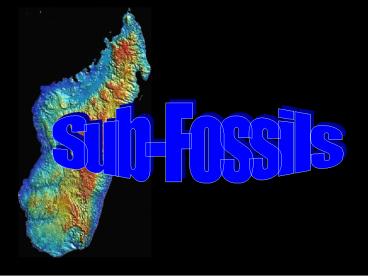In the late 19th century, the 1800s, in the
1 / 14
Title:
In the late 19th century, the 1800s, in the
Description:
Sub-Fossils. In the late 19th century, the 1800's, in the. central plateau of Madagascar a ... in Madagascar. are lemurs. How do we know these fossils are ... –
Number of Views:83
Avg rating:3.0/5.0
Title: In the late 19th century, the 1800s, in the
1
(No Transcript)
2
In the late 19th century, the 1800s, in the
central plateau of Madagascar a
sub-fossil was uncovered!
3
A scientist by the name of Elywn L Simmons deduc
ed that the sub-fossils uncovered in Madagasca
r
are lemurs.
4
How do we know these fossils are lemurs?
5
Big brain
Bone bar around eye
Big nose
36 Teeth
6
So. I have three questions to ask you.
What is a sub-fossil?
Who where the sub-fossil lemurs?
What happened to the sub-fossil lemurs?
7
Sub-FOSSIL
What is a fossil?
How does a fossil become a fossil?
8
Fossil from the Latin word meaning dug up.
Any organism can leave a fossil. In order to
leave a fossil, organic material changes from i
t original
material into a mineral.
0.1 of organic remains fossilize.
9
Bones and shells fossil best, but all things c
an fossilize.
10
The steps to fossilization and
discovery 1. Burial 2. Conversion
of organic material into rock. 3.
Discovery
11
Burial
Burial is important for fossilization. Burial
protects a bone. If a bone is not buried, sca
vengers may eat the remains, or the bone will
decay. Without burial, a bone can decay in 10
years or less.
12
Conversion Bone to Rock
Conversion is a VERY SLOW Process. It can take m
illions of year to occur. Dirt builds up over
a burial. The Pressure from the dirt builds up
and drives water out of the bone and dirt and t
urns it into ROCK. Bone which is made up of ca
lcium Converts into rock. The most common are c
alcite aragonite, quartz and silica.
13
Discovery
At the same time as fossilization is occurring,
other geological processes such as mountain forma
tion may raise the fossil to the surface, where
weathering and erosion may eventually
expose a fossil.
14
So what is a sub-fossil?
An almost complete fossil. Sub-fossils are foss
ils that have been discovered before the convers
ion process is complete. Sub-fossil are foss
ils, but they have not reached the rock stage.































